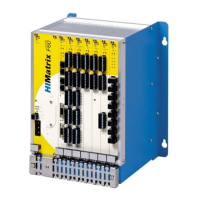System Manual Modular Systems 7 Start-Up
HI 800 191 E Rev. 2.02 Page 81 of 114
The following table specifies the parameters for configuring the user program:
For future applications in which a resource is able
to process multiple program instances
simultaneously.
It determines the maximum cycle time portion that
must not be exceeded by the program instance. If
this time portion is exceeded, the program enters
the STOP state.
Note: Maintain the default setting 0 (no special
cycle time monitoring).
Off, Cold Start,
Warm Start
The user program starts automatically after
powering on
Structure of the resource memory required and
expected for performing a code generation.
Compatibility with previous controller
versions is ensured.
Compatibility with future controller
versions.
Table 46: User program Parameters - up to CPU OS V7
The parameters specified above can be accessed via the ELOP II Factory Hardware
Management.
To change the user program parameters
1. Right-click the resource and select Properties. The Properties dialog box appears.
Enter the values in the input boxes or check the corresponding checkboxes.
2. Define the values for Autostart (Off, Cold Start, Warm Start) in the Properties menu for the
type instance of the corresponding resource. With cold start, the system initializes all signal
values, with warm start, it reads the signal values of retain variables from the non-volatile
memory.
The settings for the user program are thus defined.
7.7.3 Configuring the Inputs and Outputs
The Signal Connections pane for an I/O module or a remote I/O in the Hardware Management
is used to connect the signals previously defined in the Signal Editor to the individual hardware
channels (inputs and outputs).
To configure the inputs or outputs
1. Click the Signals menu to open the Signal Editor.
2. Right-click the module or the module or remote I/O and select Connect Signals on the
context menu.
The Signal Connections pane appears. It contains the Inputs and Outputs tabs.
3. Position the two dialog boxes adjacently to get a better overview.
4. Drag the signals onto the inputs located in the Signal Connections pane.
5. To connect the signals for the outputs, select the Outputs tab and proceed as described for
the inputs.
The inputs and outputs are now connected and thus effective in the user program.
Refer to the manual for the individual modules or remote I/Os, Chapter Signals and Error Codes
for the Inputs and Outputs for a description of the signals available for configuring the
corresponding module or remote I/O.
With the Inputs and Outputs tabs of the Signal Connections pane, observe the following points:

